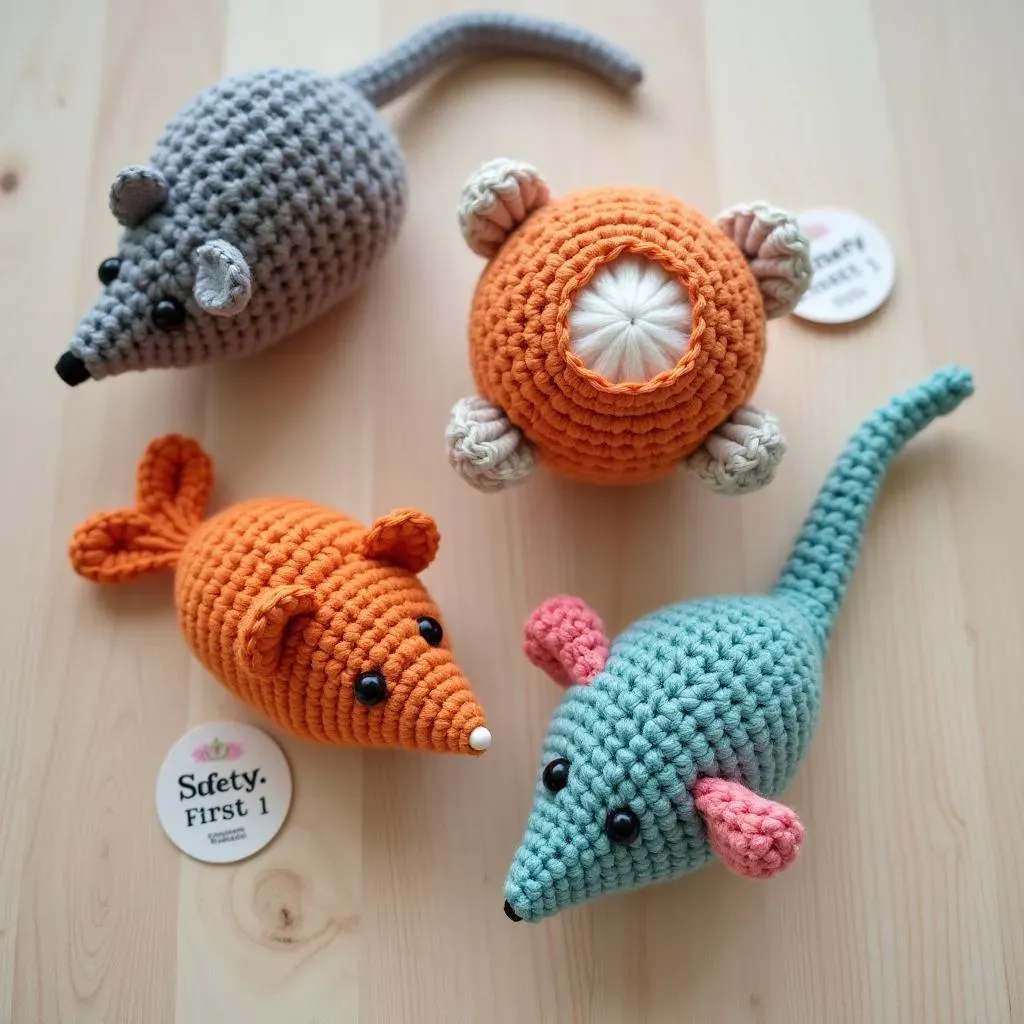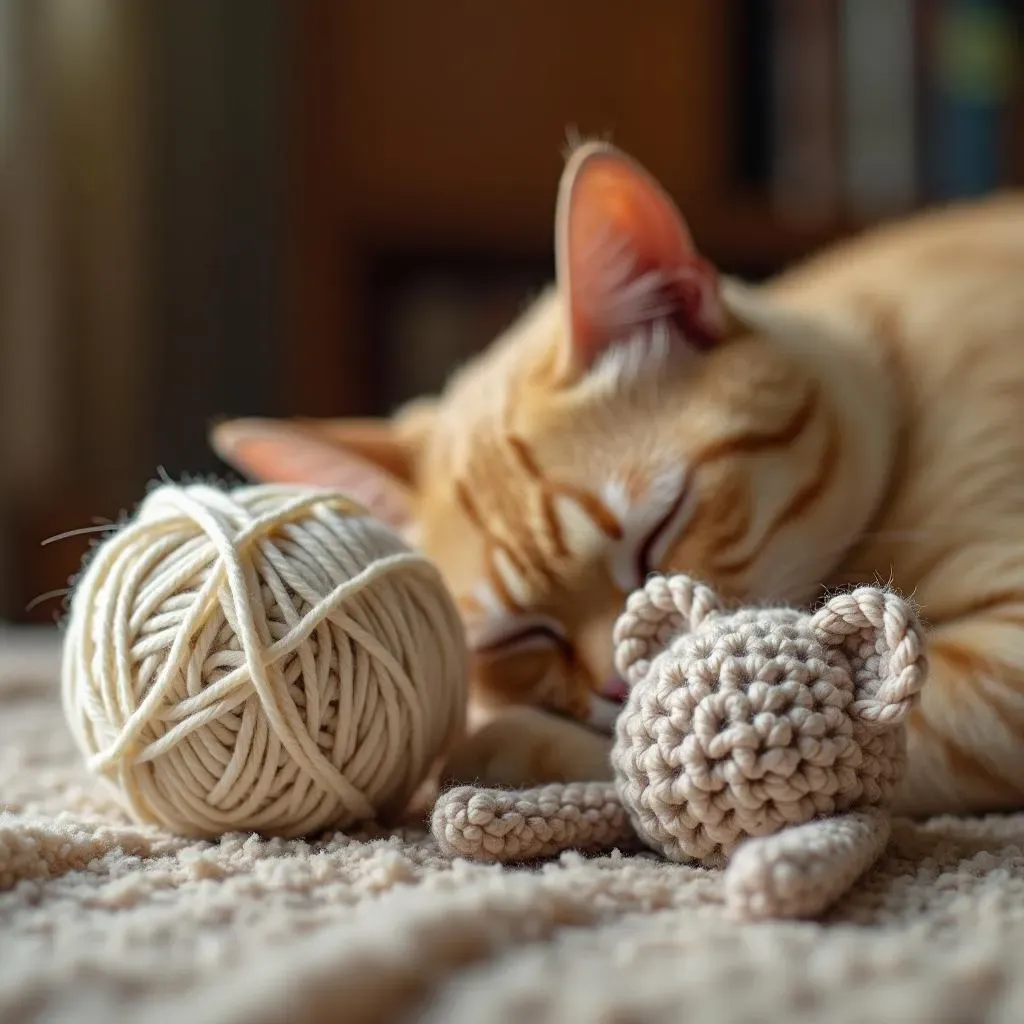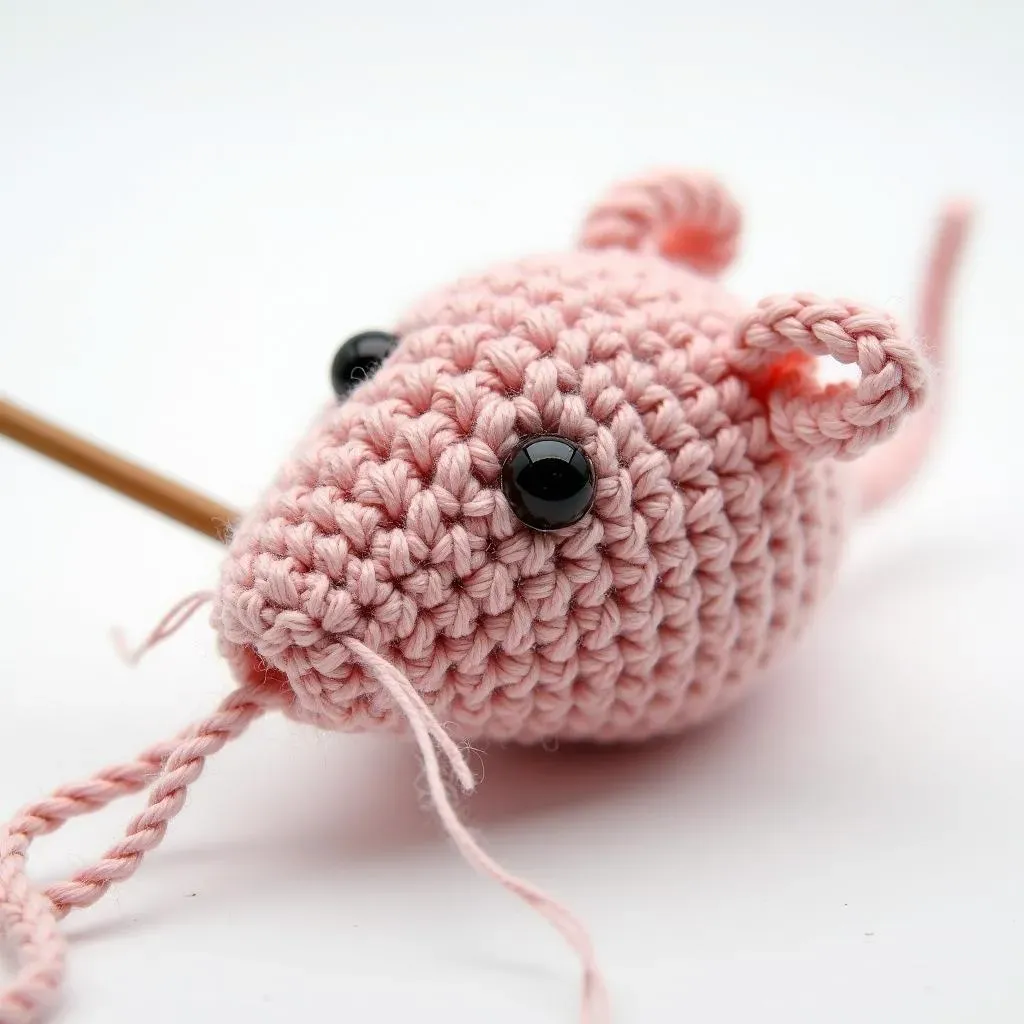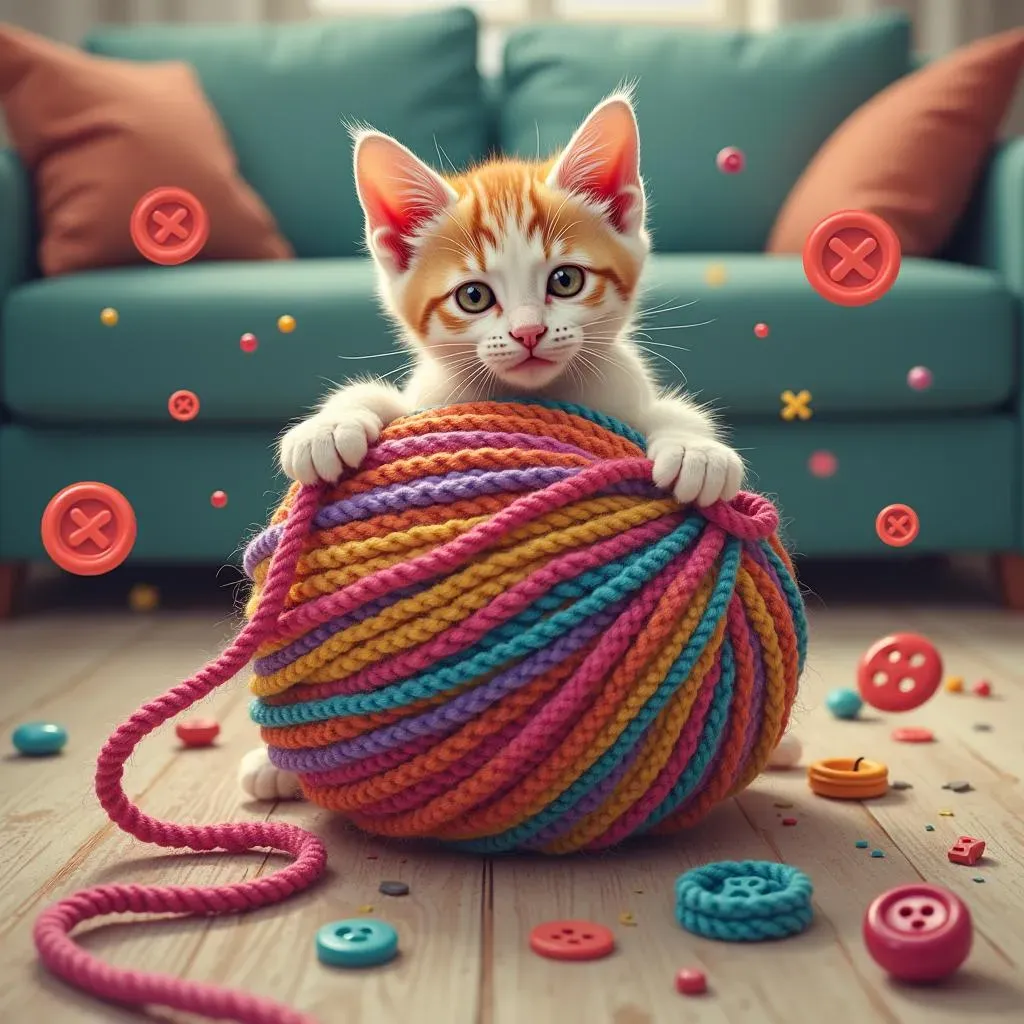Table of Contents
Ever watched your cat bat around a colorful ball of yarn and wondered, "Are crochet toys safe for cats?" You're not alone! Many cat owners are drawn to the charm of handmade crochet toys, but ensuring your feline friend's safety is paramount. This article dives deep into the world of crochet cat toys, exploring everything from material selection to construction techniques, and potential hazards to watch out for. We'll unravel the secrets to creating or choosing crochet toys that provide hours of fun without compromising your cat's well-being. So, whether you're a seasoned crocheter or a concerned cat parent, get ready to learn how to make playtime both enjoyable and safe. We'll cover the best yarn choices, smart construction methods, and how to spot and avoid potential risks. Let's get started on crafting a safer, more playful world for your furry companion!
Why Cats Love Crochet Toys: A Feline Fascination

Why Cats Love Crochet Toys: A Feline Fascination
The Allure of Texture and Movement
Ever notice how your cat goes wild for that one specific toy? Chances are, it's got something to do with texture. Crochet toys offer a unique tactile experience for cats. The woven loops and varied yarn types provide a stimulating surface for them to knead, bite, and claw. Think about it – it's like a mini scratching post and cuddle buddy all in one! Plus, the lightweight nature of crochet toys means they're easily batted around, mimicking the movement of prey and triggering your cat's natural hunting instincts. That erratic bounce? Pure feline entertainment.
It's not just about the texture, though. The open weave of crochet can also hold scents really well. Consider adding a pinch of catnip inside (in a secure pouch, of course!). The aroma will permeate the yarn, making the toy even more irresistible to your furry friend. It’s like catnip delivery system cleverly disguised as a toy!
Satisfying the Hunting Instinct: Why Crochet Toys Captivate
Cats are born hunters, even if their biggest prey these days is the laser pointer dot. Crochet toys tap into this primal instinct by providing a safe and engaging outlet for their energy. The small size and pliable nature of many crochet toys make them perfect for pouncing, chasing, and carrying around. They can sink their claws in without causing damage (to your furniture, at least!), and the give of the yarn provides a satisfying resistance.
Furthermore, the variety of shapes and sizes you can create with crochet means endless possibilities for play. From simple mice to elaborate amigurumi creatures, you can tailor the toy to your cat's specific preferences. Do they love to kick? Make a long, sausage-shaped toy. Are they obsessed with batting things around? A small, lightweight ball is the way to go. It’s all about understanding what makes your cat tick and crafting a toy that caters to those desires.
Safety First: Key Considerations for Crochet Toys and Your Cat

Safety First: Key Considerations for Crochet Toys and Your Cat
Material Matters: Choosing Cat-Friendly Yarns
When it comes to crochet toys, the yarn you choose is crucial. Not all yarns are created equal, especially when a curious cat is involved. Opt for natural fibers like cotton or wool. These are generally safer for cats if ingested in small amounts. Avoid synthetic yarns like acrylic or polyester, as they can be harder to digest and may contain chemicals. Also, steer clear of novelty yarns with metallic threads, glitter, or other embellishments that could be choking hazards. Think simple, durable, and cat-safe!
Consider using organic cotton yarn. It eliminates exposure to pesticides and other harmful substances. Look for yarns specifically labeled as "baby-safe" or "hypoallergenic." They undergo testing for harmful chemicals and dyes. Remember, a little extra care in yarn selection can make a big difference in your cat's safety.
Construction is Key: Tight Stitches and Secure Ends
A well-made crochet toy is a safe crochet toy. Tight, dense stitches are essential to prevent your cat's claws from getting caught and to minimize the risk of unraveling. Use a smaller crochet hook than recommended for your yarn to create a firmer fabric. Work in continuous rounds whenever possible to eliminate seams that could come apart. And most importantly, securely weave in all yarn ends. Those loose ends are just begging to be chewed on and swallowed!
Reinforce any attached parts, such as ears or tails, with extra stitching. Consider using embroidery floss to add facial features instead of plastic eyes. If you absolutely must use plastic eyes, make sure they are securely attached with a strong adhesive and covered with a layer of crochet. Regular inspection of the toy is also very important.
Stuffing Smart: Avoiding Hazards from the Inside Out
What you stuff your crochet toy with is just as important as the yarn you use. Toy-grade polyester fiberfill is a popular choice because it's washable and non-allergenic. However, be sure to use a generous amount to create a firm, dense toy. This prevents your cat from easily tearing into it and accessing the stuffing. Alternatively, you could use organic cotton or wool scraps as stuffing, but make sure they are clean and free of any dyes or chemicals.
Avoid using materials like beanbag pellets, polystyrene beads, or dried beans as stuffing. These can be toxic or pose a serious choking hazard if ingested. If you're adding catnip, enclose it in a separate, securely stitched pouch inside the toy to prevent your cat from directly accessing it. It’s all about layers of protection!
Stuffing Material | Safety | Considerations |
|---|---|---|
Polyester Fiberfill | Generally Safe | Use generously for a firm toy |
Organic Cotton/Wool | Safe | Ensure clean and chemical-free |
Beanbag Pellets | UNSAFE | Toxic and choking hazard |
Choosing the Right Yarn: Materials Matter When Crocheting Cat Toys

Choosing the Right Yarn: Materials Matter When Crocheting Cat Toys
Natural Fibers: The Go-To Choice for Safety
Alright, let's talk yarn! When it comes to crocheting toys for your feline overlords, natural fibers are your best bet. Think cotton, wool, or even bamboo. Why? Because they're generally safer if your cat decides to sample the merchandise. Cotton is breathable, washable, and readily available in a rainbow of colors. Wool is soft, warm, and has a natural crimp that makes it fun for cats to chew on (though watch out for felting!). Bamboo is a sustainable option that's also hypoallergenic. Just make sure whatever you choose is free of harsh dyes or chemical treatments. You want your kitty to enjoy their toy, not ingest something nasty!
Now, I know what you might be thinking: "But aren't natural fibers more expensive?" Sometimes, yes. But consider it an investment in your cat's health and well-being. Plus, a little goes a long way when you're crocheting small toys. You can also look for sales or use up leftover yarn from other projects. The peace of mind knowing you're giving your cat a safe toy is priceless.
Synthetic Yarns: Proceed with Caution
let's be real: synthetic yarns like acrylic are tempting. They're cheap, come in every color imaginable, and are super easy to care for. But here's the deal: acrylic and other synthetics aren't the safest choice for cat toys. They can be difficult for cats to digest if ingested, and some may contain chemicals that could irritate your cat's skin or digestive system. Plus, they tend to pill and shed more easily, creating a potential choking hazard.
If you absolutely must use a synthetic yarn, look for one that's labeled as "baby-safe" or "hypoallergenic." These yarns undergo testing for harmful substances. Also, be extra vigilant about checking the toy regularly for signs of wear and tear. If you see any loose strands or pilling, retire the toy immediately. Ultimately, natural fibers are the safer option, but with careful selection and monitoring, you can make synthetics work in a pinch. Just remember, your cat's safety is the top priority!
Yarn Type | Pros | Cons | Safety Rating |
|---|---|---|---|
Cotton | Breathable, washable, readily available | Can be less durable than synthetics | High |
Wool | Soft, warm, naturally crimped | May felt, requires handwashing | High |
Acrylic | Cheap, wide color selection, easy care | Difficult to digest, may contain chemicals | Low to Moderate (use with caution) |
Construction Counts: How to Crochet Safe and Durable Toys for Cats

Construction Counts: How to Crochet Safe and Durable Toys for Cats
Stitch Selection: The Foundation of Durability
Alright, listen up, because this is where the magic happens! The type of stitch you use is crucial when you're aiming for a cat-proof crochet toy. Forget those loose, lacy patterns – we're going for maximum density here. Single crochet is your best friend. It creates a tight, firm fabric that's less likely to unravel, even when faced with sharp claws and determined teeth. If you're feeling fancy, you can try waistcoat stitch (also known as knit stitch), which is even denser than single crochet. Trust me, your cat will have a harder time destroying these bad boys!
Avoid using stitches like double crochet or treble crochet, as they create larger gaps that can snag claws and lead to unraveling. Consistency is key, too. Keep your tension even throughout the project to ensure a uniform fabric. A wobbly, uneven stitch will weaken the overall structure of the toy. Think of it like building a house – you need a solid foundation to withstand the elements (or, in this case, a playful kitty!).
Seamless Construction: Minimizing Weak Points
Seams are the enemy of durable crochet toys. They're often the first point of failure, where the toy starts to unravel or come apart. That's why seamless construction is so important. Working in continuous rounds (also known as spiral crochet) is the best way to achieve this. Instead of joining each round, you simply keep crocheting around and around, creating a smooth, unbroken surface. This eliminates those pesky seams and makes the toy much stronger.
If you absolutely must create a seam (for example, when attaching limbs or other features), be sure to use a strong, secure joining method. Mattress stitch is a great option because it creates an invisible seam that's almost as strong as the surrounding fabric. Reinforce the seam with extra stitching, and weave in the ends carefully to prevent them from coming loose. Remember, every detail matters when you're building a toy that's meant to withstand some serious abuse!
Construction Method | Pros | Cons | Durability |
|---|---|---|---|
Continuous Rounds (Spiral Crochet) | Seamless, strong, minimizes weak points | Can be tricky for beginners | High |
Joined Rounds | Easier for beginners | Creates seams, potential weak points | Moderate |
Mattress Stitch (for seams) | Invisible seam, strong and secure | Requires careful execution | High |
Reinforcements and Finishing Touches: Adding Extra Protection
So, you've chosen the right stitch, mastered seamless construction, and now it's time for the finishing touches that will take your crochet toy to the next level. Reinforcing any attached parts, such as ears, tails, or limbs, is crucial. Use extra stitching to secure these pieces firmly to the body of the toy. Consider using embroidery floss or strong thread for added durability. If you're adding facial features, embroider them on instead of using plastic eyes. Plastic eyes can be a choking hazard if they come loose, no matter how securely you think they are attached.
Finally, take the time to carefully weave in all yarn ends. This is not the place to cut corners! Use a yarn needle to thread the ends through several stitches, changing direction frequently to lock them in place. Trim the ends close to the fabric, but not so close that they might unravel. A little extra effort at this stage will prevent your cat from pulling out the stuffing and potentially ingesting it. You've put in the work, so don't let a few loose ends ruin your masterpiece!
- Reinforce attached parts with extra stitching.
- Embroider facial features instead of using plastic eyes.
- Weave in all yarn ends carefully and securely.
Risks and Mitigation: Ensuring Crochet Toys Are Safe for Cats

Risks and Mitigation: Ensuring Crochet Toys Are Safe for Cats
Ingestion Hazards: What Happens if They Swallow It?
let's face it: cats are gonna cat. They chew, they lick, they sometimes swallow things they shouldn't. That's why ingestion is a major risk when it comes to crochet toys. Small pieces of yarn, stuffing, or embellishments can cause gastrointestinal blockages, which can be serious and even life-threatening. So, how do you mitigate this risk? First, choose your materials wisely (as we've already discussed!). Second, inspect the toys regularly for signs of wear and tear. If you see any loose strands, holes, or missing parts, retire the toy immediately. Third, consider making larger toys that are less likely to be swallowed whole. And finally, supervise your cat during playtime, especially when they're first introduced to a new toy. If you see them chewing excessively or trying to swallow pieces, take the toy away.
It's also a good idea to familiarize yourself with the symptoms of a gastrointestinal blockage in cats. These can include vomiting, diarrhea, loss of appetite, lethargy, and abdominal pain. If you suspect your cat has ingested part of a crochet toy and is showing any of these symptoms, contact your veterinarian immediately. Time is of the essence when it comes to treating blockages. Prevention is always better than cure, but being prepared for the worst can save your cat's life.
Entanglement Issues: Avoiding Stringy Situations
Entanglement is another potential hazard associated with crochet toys, especially those with long, dangly parts. Cats can get tangled in loose strands of yarn or attached ribbons, which can restrict their movement, cut off circulation, or even lead to strangulation. To minimize this risk, avoid designing toys with long, trailing strings or tassels. If you do include ribbons or other decorative elements, make sure they are securely attached and relatively short. Regularly inspect the toys for loose strands and trim them immediately. And never leave your cat unattended with a toy that has the potential to cause entanglement.
Consider using safety eyes instead of regular plastic eyes. Safety eyes have a locking mechanism that makes them much harder to pull out. However, even safety eyes can come loose over time, so it's still important to check them regularly. If you're really concerned about safety, embroidering the eyes is always the safest option. It may take a little more time and effort, but it's worth it for the peace of mind.
Risk | Mitigation Strategy | Additional Tips |
|---|---|---|
Ingestion | Choose safe materials, inspect toys regularly, supervise playtime | Familiarize yourself with symptoms of GI blockage |
Entanglement | Avoid long strings, secure attachments, trim loose strands | Never leave cat unattended with potentially hazardous toys |
Choking | Avoid small parts, use larger toy sizes, embroider details | Consider using safety eyes instead of regular plastic eyes |
Choking Risks: Keeping Small Parts Secure
Choking is a serious concern with any cat toy, but it's especially relevant to crochet toys that may contain small parts like beads, buttons, or plastic eyes. Cats can accidentally swallow these small objects, which can lodge in their throat and block their airway. To prevent choking hazards, avoid using small parts altogether. If you want to add details to your crochet toy, embroider them on instead of using beads or buttons. Choose larger toy sizes that are less likely to be swallowed whole. And always supervise your cat during playtime to make sure they're not trying to ingest anything they shouldn't.
If you suspect your cat is choking, look for signs like gagging, coughing, difficulty breathing, or blue gums. If you know how to perform the Heimlich maneuver on a cat, do so immediately. If you're not comfortable performing the Heimlich maneuver, take your cat to the veterinarian as quickly as possible. Again, time is of the essence when it comes to treating choking. Being prepared and knowing what to do in an emergency can save your cat's life.
Conclusion: Crochet Toys and Happy, Safe Cats
So, are crochet toys safe for cats? The answer is a resounding yes, with a few crucial caveats. By choosing the right materials, employing smart construction techniques, and diligently monitoring playtime, you can provide your feline friend with engaging and safe crochet toys. Remember to prioritize natural, durable yarns, avoid small or detachable parts, and regularly inspect toys for wear and tear. With a little care and attention, crochet toys can be a wonderful addition to your cat's playtime repertoire, offering enrichment and joy without compromising their safety. Happy crocheting, and here's to many happy, safe play sessions with your beloved cat!